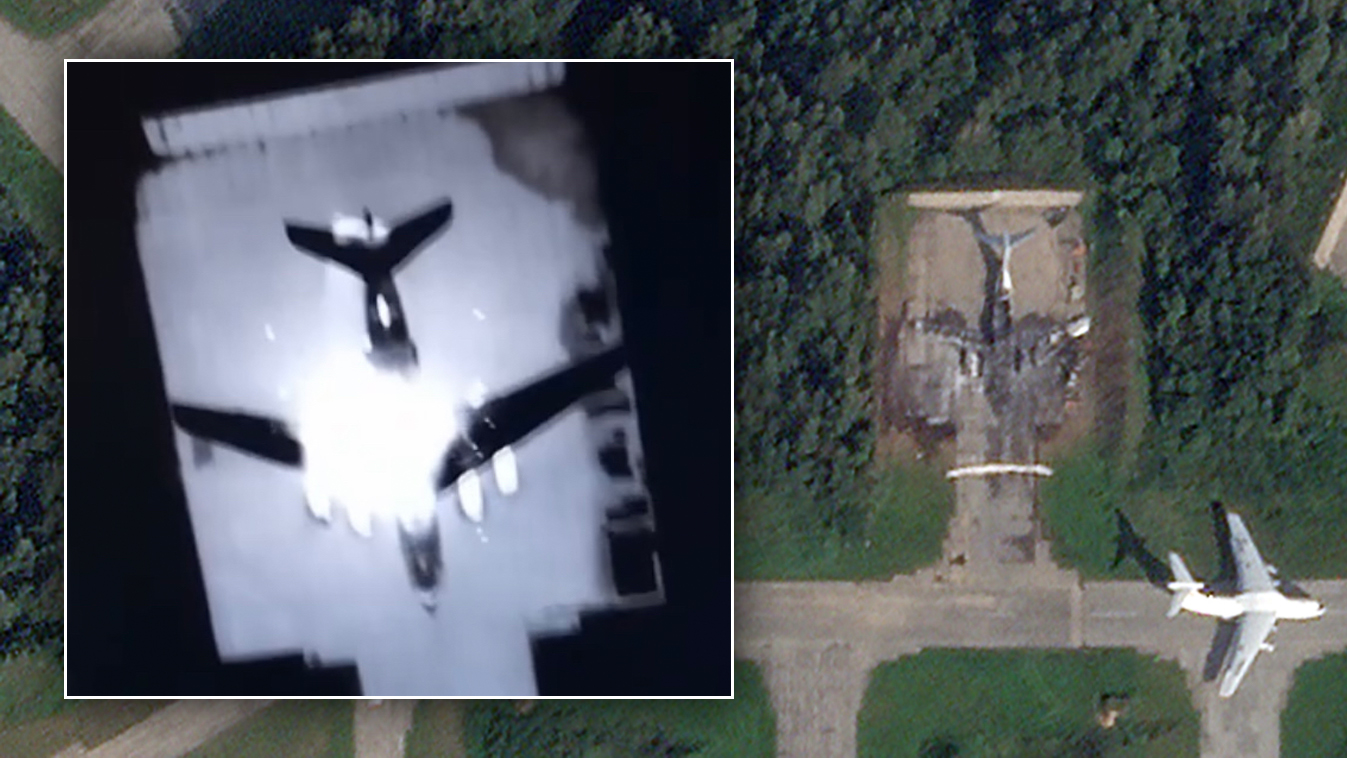New satellite images obtained by The War Zone show that at least two Il-76 Candid heavy cargo aircraft were destroyed and two others damaged in a drone attack on Kresty Air Base in Pskov Oblast during the overnight hours of Aug. 29. We also obtained a infrared camera image that shows one of the aircraft the moment it was attacked.
The post-attack images from Planet Labs show the charred remains of two Candids and two that appear to display damage to the top of their fuselages at the midpoint of the aircraft where the wings are attached.




Early this morning, we reviewed another set of images of the base that obscured much of its aircraft parking areas. Still, to the south, the two Il-76s were seen with damage to their upper fuselages. Those aircraft have since been towed out to the adjacent taxiway.
We compared these images to ones we obtained from Aug. 16, which proved the scorch-like marks are indeed unique as no airlifters on the sprawling base had anything like them days prior to the attack.

The top of the aircraft is where the cargo jets’ fuel tanks and a critical section of the wing spar are located. Those sections of the aircraft were specifically targeted by the drones, which were launched from inside Russia, Ukrainian Maj. Gen. Kyrylo Budanov, head of the Defense Intelligence Directorate (GUR), told The War Zone exclusively Thursday.
“We are working from the territory of Russia,” Budanov told us, though he would not specify whether the attack was carried out by GUR personnel or Russian partisans. He also declined to say what kind of drones were used or how many.
The images also back up what Budanov told us about the extent of the damage caused during the attack.
In his battle damage assessment of the aircraft, Budanov told us that “two were destroyed and two were seriously damaged.”
We also obtained a screen capture from an infrared camera video feed from one of the drones used in the attack. The image, provided by a GUR source, shows the immediate result of one of the strikes, hitting in the same spot where two of the Candids show damage. Fuel onboard may have been a factor with the other two burning out completely, but we can assumed the same critical area was targeted.

The infrared image would mean these were likely bomblets dropped from a drone or drones under local man-in-the-loop control unless the source of the image was acting as an observation drone to record the strike, which seems unlikely. This would fit Budanov’s comments that this was a strike launched inside Russia, likely very near the base, and not one using long-range autonomous drones. The video from which the still we obtained was captured looks like the drone had dropped one of the bomblets.
This successful attack raises additional questions about Russian force protection defenses and its ability to counter drone operations over its domestic airbase facilities. After an attack last month on the Stoltsy-2 Air Base inside Russia, GUR spokesman Andrii Yusov told us it was carried out on the GUR’s behest by people inside Russia. Later, Russian officials ordered increased patrols around that base, searching for collaborators and any equipment that they could use.
Unconfirmed reports shortly after this latest drone attack suggested that up to 20 drones may have targeted the base, as part of a large-scale and complex series of drone attacks across Russia.
Shortly after the operation, vivid videos emerged showing huge flames at the base and at least one aircraft ablaze.
It’s possible another reason why this base and its transports were targeted was that the defensive posture was not as robust as that seen at Russian bomber bases, which have come under repeated attack, or other installations that support kinetic operations.
The Il-76s are the backbone of Russia’s military aviation lift, playing a role similar to that of U.S. Air Force C-17s. Budanov told us that GUR specifically targeted these aircraft because they were in working order and are being used to “transport military cargo and paratroopers from the Airborne Division.”
“The airbase is home to the 334th Military Transport Aviation Regiment — or 334 VTAP in its Russian abbreviation — which has been operating the Il-76 from here since 1979. The base is thought to operate up to around 20 Il-76s. If claims that four of the transports were damaged are accurate, that would represent a significant portion of the resident fleet.”
There are a total of about 100 operational Il-76s in the entire Russian Air Force.

The Oryx open-source tracking group, based on the same images, is now listing two Candids at the base destroyed and two as “damaged beyond economical repair.” Considering the limitations of commercial satellite imagery, The War Zone cannot ascertain if the two damaged airframes are salvageable or not.

How big a hit this attack puts on Russia’s abililty to deliver cargo and troops by air remains to be seen, but it is a good bet that Ukraine will continue such attacks as it take the war into Russia.
Update 6:26 P.M. Eastern:
Images purporting to be air defenses being activated at or near the Kresty Air Base in Pskov Oblast in the past hour or so are emerging on social media, including one posted by the regional governor on his Telegram channel
“In the Krestov area, observers at one of the airspace control posts found a single unidentified object in the sky,” Mikhail Vedernikov said. “In the video, measures to neutralize it. There are no consequences on earth. Details later.”
There is no mention of the attack on the Russian Defense Ministry (MoD) Telegram channel and no immediate response by Ukrainian officials. Given that these videos were posted at night and in the fog of war, it may be several hours, once the sun comes up, until we get more solid details.
Contact the author: howard@thewarzone.com
